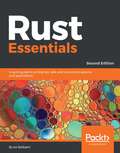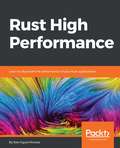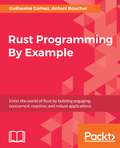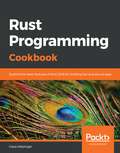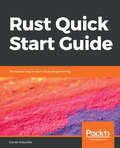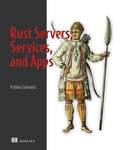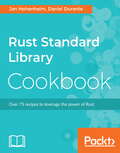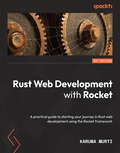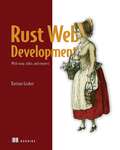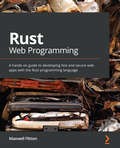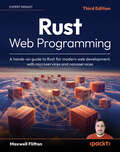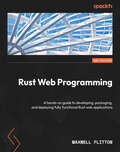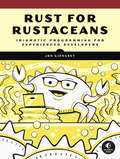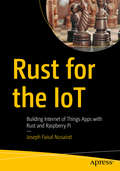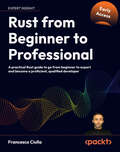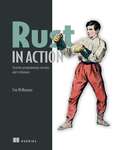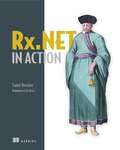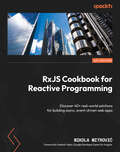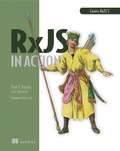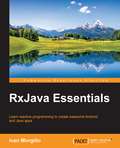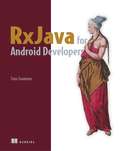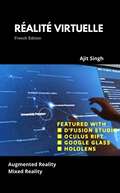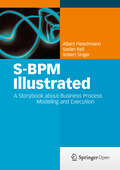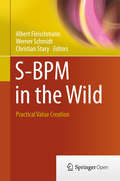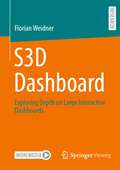- Table View
- List View
Rust Essentials - Second Edition: A quick guide to writing fast, safe, and concurrent systems and applications
by Ivo BalbaertLeverage the functional programming and concurrency features of Rust and speed up your application development About This Book • Get started with Rust to build scalable and high performance applications • Enhance your application development skills using the power of Rust • Discover the power of Rust when developing concurrent applications for large and scalable software Who This Book Is For The book is for developers looking for a quick entry into using Rust and understanding the core features of the language. Basic programming knowledge is assumed. What You Will Learn • Set up your Rust environment to achieve the highest productivity • Bridge the performance gap between safe and unsafe languages • Use pattern matching to create flexible code • Apply generics and traits to develop widely applicable code • Organize your code in modules and crates • Build macros to extend Rust's capabilities and reach • Apply tasks to tackle problems concurrently in a distributed environment In Detail Rust is the new, open source, fast, and safe systems programming language for the 21st century, developed at Mozilla Research, and with a steadily growing community. It was created to solve the dilemma between high-level, slow code with minimal control over the system, and low-level, fast code with maximum system control. It is no longer necessary to learn C/C++ to develop resource intensive and low-level systems applications. This book will give you a head start to solve systems programming and application tasks with Rust. We start off with an argumentation of Rust's unique place in today's landscape of programming languages. You'll install Rust and learn how to work with its package manager Cargo. The various concepts are introduced step by step: variables, types, functions, and control structures to lay the groundwork. Then we explore more structured data such as strings, arrays, and enums, and you'll see how pattern matching works. Throughout all this, we stress the unique ways of reasoning that the Rust compiler uses to produce safe code. Next we look at Rust's specific way of error handling, and the overall importance of traits in Rust code. The pillar of memory safety is treated in depth as we explore the various pointer kinds. Next, you'll see how macros can simplify code generation, and how to compose bigger projects with modules and crates. Finally, you'll discover how we can write safe concurrent code in Rust and interface with C programs, get a view of the Rust ecosystem, and explore the use of the standard library. Style and approach The book takes a pragmatic approach, showing various methods to solve systems programming tasks with Rust and develop resource intensive and low-level systems applications.
Rust High Performance: Learn to skyrocket the performance of your Rust applications
by Iban Eguia MorazaFind bottlenecks, identify the proper algorithm to use, optimize performance, and create really efficient Rust applicationsKey Features Understand common performance pitfalls and improve the performance of your applications. Get to grips with parallel programming and multithreading with Rust. Learn metaprogramming in Rust.Book DescriptionAt times, it is difficult to get the best performance out of Rust. This book teaches you to optimize the speed of your Rust code to the level of languages such as C/C++. You'll understand and fix common pitfalls, learn how to improve your productivity by using metaprogramming, and speed up your code by concurrently executing parts of it safely and easily. You will master the features of the language which will make you stand out and use them to really improve the efficiency of your algorithmsThe book begins with a gentle introduction to help you identify bottlenecks when programming in Rust. We highlight common performance pitfalls, along with strategies to detect and resolve these issues early. We move on to mastering Rust's type system, which will enable us to create impressive optimizations in both performance and safety at compile time. You will then learn how to effectively manage memory in Rust, mastering the borrow checker. We move on to measuring performance and you will see how this affects the way you write code. Moving ahead, you will perform metaprogramming in Rust to boost the performance of your code and your productivity. You will finally learn parallel programming in Rust, which enables efficient and faster execution by using multithreading and asynchronous programming.What you will learn Master tips and tricks to make your code faster. Learn how to identify bottlenecks in your Rust applications Discover how to profile your Rust software. Understand the type system to create compile-time optimizations. Master the borrow checker . Learn metaprogramming in Rust to avoid boilerplate code. Discover multithreading and work stealing in Rust. Understand asynchronous programming in Rust.Who this book is forThis book is for Rust developers keen to improve the speed of their code or simply to take their skills to the next level.
Rust Programming By Example: Enter the world of Rust by building engaging, concurrent, reactive, and robust applications
by Sebastian Dröge Daniel Durante Antoni Boucher Guillaume GomezDiscover the world of Rust programming through real-world examples Key Features Implement various features of Rust to build blazingly fast applications Learn to build GUI applications using Gtk-rs Explore the multi-threading aspect of Rust to tackle problems in concurrency and in distributed environments Book Description Rust is an open source, safe, concurrent, practical language created by Mozilla. It runs blazingly fast, prevents segfaults, and guarantees safety. This book gets you started with essential software development by guiding you through the different aspects of Rust programming. With this approach, you can bridge the gap between learning and implementing immediately. Beginning with an introduction to Rust, you’ll learn the basic aspects such as its syntax, data types, functions, generics, control flows, and more. After this, you’ll jump straight into building your first project, a Tetris game. Next you’ll build a graphical music player and work with fast, reliable networking software using Tokio, the scalable and productive asynchronous IO Rust library. Over the course of this book, you’ll explore various features of Rust Programming including its SDL features, event loop, File I/O, and the famous GTK+ widget toolkit. Through these projects, you’ll see how well Rust performs in terms of concurrency—including parallelism, reliability, improved performance, generics, macros, and thread safety. We’ll also cover some asynchronous and reactive programming aspects of Rust. By the end of the book, you’ll be comfortable building various real-world applications in Rust. What you will learn Compile and run the Rust projects using the Cargo-Rust Package manager Use Rust-SDL features such as the event loop, windows, infinite loops, pattern matching, and more Create a graphical interface using Gtk-rs and Rust-SDL Incorporate concurrency mechanism and multi-threading along with thread safety and locks Implement the FTP protocol using an Asynchronous I/O stack with the Tokio library Who this book is for This book is for software developers interested in system level and application programming who are looking for a quick entry into using Rust and understanding the core features of the Rust Programming. It’s assumed that you have a basic understanding of Java, C#, Ruby, Python, or JavaScript.
Rust Programming Cookbook: Explore the latest features of Rust 2018 for building fast and secure apps
by Claus MatzingerPractical solutions to overcome challenges in creating console and web applications and working with systems-level and embedded code, network programming, deep neural networks, and much more. Key Features Work through recipes featuring advanced concepts such as concurrency, unsafe code, and macros to migrate your codebase to the Rust programming language Learn how to run machine learning models with Rust Explore error handling, macros, and modularization to write maintainable code Book Description Rust 2018, Rust's first major milestone since version 1.0, brings more advancement in the Rust language. The Rust Programming Cookbook is a practical guide to help you overcome challenges when writing Rust code. This Rust book covers recipes for configuring Rust for different environments and architectural designs, and provides solutions to practical problems. It will also take you through Rust's core concepts, enabling you to create efficient, high-performance applications that use features such as zero-cost abstractions and improved memory management. As you progress, you'll delve into more advanced topics, including channels and actors, for building scalable, production-grade applications, and even get to grips with error handling, macros, and modularization to write maintainable code. You will then learn how to overcome common roadblocks when using Rust for systems programming, IoT, web development, and network programming. Finally, you'll discover what Rust 2018 has to offer for embedded programmers. By the end of the book, you'll have learned how to build fast and safe applications and services using Rust. What you will learn Understand how Rust provides unique solutions to solve system programming language problems Grasp the core concepts of Rust to develop fast and safe applications Explore the possibility of integrating Rust units into existing applications for improved efficiency Discover how to achieve better parallelism and security with Rust Write Python extensions in Rust Compile external assembly files and use the Foreign Function Interface (FFI) Build web applications and services using Rust for high performance Who this book is for The Rust cookbook is for software developers looking to enhance their knowledge of Rust and leverage its features using modern programming practices. Familiarity with Rust language is expected to get the most out of this book.
Rust Quick Start Guide: The easiest way to learn Rust programming
by Daniel ArbuckleGet familiar with writing programs in the trending new systems programming language that brings together the powerful performance of low-level languages with the advanced features like thread safety in multi-threaded codeKey FeaturesLearn the semantics of Rust, which can be significantly different from other programming languagesUnderstand clearly how to work with the Rust compiler which strictly enforces rules that may not be obviousExamples and insights beyond the Rust documentationBook DescriptionRust is an emerging programming language applicable to areas such as embedded programming, network programming, system programming, and web development. This book will take you from the basics of Rust to a point where your code compiles and does what you intend it to do!This book starts with an introduction to Rust and how to get set for programming, including the rustup and cargo tools for managing a Rust installation and development workflow.Then you'll learn about the fundamentals of structuring a Rust program, such as functions, mutability, data structures, implementing behavior for types, and many more. You will also learn about concepts that Rust handles differently from most other languages.After understanding the Basics of Rust programming, you will learn about the core ideas, such as variable ownership, scope, lifetime, and borrowing. After these key ideas, you will explore making decisions in Rust based on data types by learning about match and if let expressions. After that, you'll work with different data types in Rust, and learn about memory management and smart pointers.What you will learnInstall Rust and write your first program with itUnderstand ownership in RustHandle different data typesMake decisions by pattern matchingUse smart pointersUse generic types and type specializationWrite code that works with many data typesTap into the standard libraryWho this book is forThis book is for people who are new to Rust, either as their first programming language or coming to it from somewhere else. Familiarity with computer programming in any other language will be helpful in getting the best out of this book.
Rust Servers, Services, and Apps
by Prabhu EshwarlaDeliver fast, reliable, and maintainable applications by building backend servers, services, and frontends all in nothing but Rust.In Rust Servers, Services, and Apps, you&’ll learn: Developing database-backed web services in Rust Building and securing RESTful APIs Writing server-side web applications in Rust Measuring and benchmarking web service performance Packaging and deploying web services Full-stack Rust applications The blazingly fast, safe, and efficient Rust language has been voted &“most loved&” for multiple consecutive years on the StackOverflow survey. Rust Server, Services, and Apps shows you why! Inside, you&’ll build web servers, RESTful services, server-rendered apps, and client frontends just using Rust. You&’ll learn to write code with small and predictable resource footprints, and build high-performing applications with unmatched safety and reliability. About the technology Build speedy, stable, and safe web servers in Rust! With a unique approach to memory management and concurrency, Rust excels at getting the low-level details right so your applications run fast and flawlessly. And Rust&’s incredible compiler helps you avoid expensive mistakes when you&’re deploying web services and other core components in production. About the book Rust Servers, Services, and Apps shows you how to create modern distributed web apps using the Rust language. You&’ll start with the basics: building a simple HTTP server and a RESTful web service. Then, you&’ll make them production ready by adding security, database interactivity, and error handling. Finally, you&’ll tackle a digital storefront service, create a single page app, and dig into asynchronous programming. All examples are fully illustrated and include annotated code you can easily adapt to your own projects. What's inside Craft resilient and secure RESTful APIs Package and deploy web services Refactor fearlessly thanks to Rust&’s guaranteed safety Slash costs with Rust&’s runtime and compile-time optimizations Asynchronous programming with Rust About the reader For web developers who know the basics of Rust. About the author Prabhu Eshwarla is the CTO of a startup building a layer-1 blockchain using Rust. Previously, he held engineering and leadership roles at Hewlett Packard. Table of Contents PART 1 - WEB SERVERS AND SERVICES 1 Why Rust for web applications? 2 Writing a basic web server from scratch 3 Building a RESTful web service 4 Performing database operations 5 Handling errors 6 Evolving the APIs and fearless refactoring PART 2 - ERVER-SIDE WEB APPLICATIONS 7 Introducing server-side web apps in Rust 8 Working with templates for tutor registration 9 Working with forms for course maintenance PART 3 - ADVANCED TOPIC: ASYNC RUST 10 Understanding async Rust 11 Building a P2P node with async Rust 12 Deploying web services with Docker
Rust Standard Library Cookbook: Over 75 recipes to leverage the power of Rust
by Daniel Durante Jan Nils FernerExplore the Rust Standard library and compose algorithms with minimal dependency on external librariesKey Features Develop high-quality, fast, and portable applications by leveraging the power of Rust's Standard library. Practical recipes that will help you work with the Standard library to boost your productivity as a Rust developer. Learn about most relevant external crates to be used along with the Standard library.Book DescriptionMozilla’s Rust is gaining much attention with amazing features and a powerful library. This book will take you through varied recipes to teach you how to leverage the Standard library to implement efficient solutions.The book begins with a brief look at the basic modules of the Standard library and collections. From here, the recipes will cover packages that support file/directory handling and interaction through parsing. You will learn about packages related to advanced data structures, error handling, and networking. You will also learn to work with futures and experimental nightly features. The book also covers the most relevant external crates in Rust. By the end of the book, you will be proficient at using the Rust Standard library.What you will learn How to use the basic modules of the library: strings, command line access, and more. Implement collections and folding of collections using vectors, Deque, linked lists, and more. Handle various file types , compressing and decompressing data. Search for files with glob patterns. Implement parsing through various formats such as CSV, TOML, and JSON. Utilize drop trait , the Rust version of destructor. Resource locking with Bilocks.Who this book is forThis book is for developers who would like to explore the power of Rust and learn to use the STL for various functionalities. A basic Rust programming knowledge is assumed.
Rust Web Development with Rocket: A practical guide to starting your journey in Rust web development using the Rocket framework
by Karuna MurtiExplore the world of Rocket-fueled web application development and the power of the Rust programming languageKey FeaturesDiscover solutions to the common problems faced while creating web applications with RocketLearn everything about Rust, from structs and crates to generics and debuggingCombine Rust and Rocket to create, test, and deploy a full-featured web appBook DescriptionLooking for a fast, powerful, and intuitive framework to build web applications? This Rust book will help you kickstart your web development journey and take your Rust programming skills to the next level as you uncover the power of Rocket - a fast, flexible, and fun framework powered by Rust.Rust Web Development with Rocket wastes no time in getting you up to speed with what Rust is and how to use it. You'll discover what makes it so productive and reliable, eventually mastering all of the concepts you need to play with the Rocket framework while developing a wide set of web development skills. Throughout this book, you'll be able to walk through a hands-on project, covering everything that goes into making advanced web applications, and get to grips with the ins and outs of Rocket development, including error handling, Rust vectors, and wrappers. You'll also learn how to use synchronous and asynchronous programming to improve application performance and make processing user content easy.By the end of the book, you'll have answers to all your questions about creating a web application using the Rust language and the Rocket web framework.What you will learnMaster the basics of Rust, such as its syntax, packages, and toolsGet to grips with Rocket's tooling and ecosystemExtend your Rocket applications using Rust and third-party librariesCreate a full-fledged web app with Rocket that handles user contentWrite pattern-matching logic and handle Rust object lifetimesUse APIs and async programming to make your apps secure and reliableTest your Rocket application and deploy it to productionContainerize and scale your applications for maximum efficiencyWho this book is forThis web development book is for software engineers who want to learn how to use the Rocket framework to build web applications. Although not mandatory, basic knowledge of the Rust programming language will help you understand the topics covered easily.
Rust Web Development: With warp, tokio, and reqwest
by Bastian GruberCreate bulletproof, high-performance web apps and servers with Rust.In Rust Web Development you will learn: Handling the borrow checker in an asynchronous environment Learning the ingredients of an asynchronous Rust stack Creating web APIs and using JSON in Rust Graceful error handling Testing, tracing, logging, and debugging Deploying Rust applications Efficient database access Rust Web Development is a pragmatic, hands-on guide to creating server-based web applications with Rust. If you&’ve designed web servers using Java, NodeJS, or PHP, you&’ll instantly fall in love with the performance and development experience Rust delivers. Hit the ground running! Author Bastian Gruber&’s sage advice makes it easy to start tackling complex problems with Rust. You&’ll learn how to work efficiently using pure Rust, along with important Rust libraries such as tokio for async runtimes, warp for web servers and APIs, and reqwest to run external HTTP requests. About the technology If you&’re sick of cookie-cutter web development tools that are slow, resource hungry, and unstable, Rust is the solution. Rust services deliver rock-solid safety guarantees, an amazing developer experience, and even a compiler that automatically prevents common mistakes! About the book Rust Web Development, teaches you to build server-side web apps using Rust, along with important Rust libraries like tokio for async runtimes, warp for web servers and APIs, and reqwest to run external HTTP requests. The book is packed full of examples, code samples, and pro tips for setting up your projects and organizing your code. As you go, you&’ll build a complete Q&A web service and iterate on your code chapter-by-chapter, just like a real development project. What's inside Handle the borrow checker in an asynchronous environment Build web APIs and handle JSON Compose a tech stack for asynchronous Rust development Handle errors gracefully Test, trace, log, and debug Deploy Rust applications to multiple environments About the reader This book is for web developers familiar with Java, Node, or Go, and the absolute basics of Rust. About the author Bastian Gruber is a Protocol Engineer at Centrifuge. He was part of the official Rust Async Working Group, and founded the Rust and Tell Berlin MeetUp group. Table of Contents PART 1 INTRODUCTION TO RUST 1 Why Rust? 2 Laying the foundation PART 2 GETTING STARTED 3 Create your first route handler 4 Implement a RESTful API 5 Clean up your codebase 6 Logging, tracing, and debugging 7 Add a database to your application 8 Integrate third-party APIs PART 3 BRING IT INTO PRODUCTION 9 Add authentication and authorization 10 Deploy your application 11 Testing your Rust application
Rust Web Programming
by Maxwell FlittonThis book on web programming with Rust is for web developers who have programmed in traditional languages such as Python, Ruby, JavaScript, and Java and are looking to develop high-performance web applications with Rust. Although no prior experience with Rust is necessary, a solid understanding of web development principles and basic knowledge of HTML, CSS, and JavaScript are required if you want to get the most out of this book.
Rust Web Programming: A hands-on guide to Rust for modern web development, with microservices and nanoservices
by Maxwell FlittonA comprehensive guide to developing, packaging, and deploying Rust web applications – with new coverage on async Rust, WebAssembly, nanoservices, and more. Purchase of the print or Kindle book includes a free eBook in PDF format.Key FeaturesGet a comprehensive introduction to Rust for full-stack web developmentExplore the exciting evolution of Rust in recent years with WebAssembly, Axum, native TLS, and SurrealDBBuild code in a scalable way with microservice and nanoservice design patternsBook DescriptionRust is no longer just for systems programming. This book will show you why this safe and performant language is a crucial up-and-coming option for developing web applications, and get you on your way to building fully functional Rust web apps. You don’t need any experience with Rust to get started, and this new edition also comes with a shallower learning curve. You’ll get hands-on with emerging Rust web frameworks including Actix, Axum, Rocket, and Hyper. You’ll look at injecting Rust into the frontend with WebAssembly and HTTPS configuration with NGINX. Later, you’ll move onto more advanced async topics, exploring TCP and framing, and implementing async systems. As you work through the book, you’ll build a to-do application with authentication using a microservice architecture that compiles into one Rust binary, including the embedding of a frontend JavaScript application in the same binary. The application will have end-to-end atomic testing and a deployment pipeline. By the end of this book, you’ll fully understand the significance of Rust for web development. You’ll also have the confidence to build robust, functional, and scalable Rust web applications from scratch.What you will learnBuild scalable Rust web applications as monoliths or microservicesDevelop a deeper understanding of async RustGet to grips with Rust language features like traits and the borrow checkerManage authentication and databases in Rust web appsBuild app infrastructure on AWS using TerraformLearn how to package and deploy Rust serversBuild unit tests and end-to-end tests for your Rust web apps with PythonWho this book is forThis book is for web developers who are looking to learn or adopt Rust to build safe and performant web applications. This includes developers familiar with languages such as Python, Ruby, and JavaScript. You don’t need any prior experience in Rust to start this book. However, you’ll need a solid understanding of web development principles, along with basic knowledge of HTML, CSS, and JavaScript to get the most out of it.
Rust Web Programming: A hands-on guide to developing, packaging, and deploying fully functional Rust web applications, 2nd Edition
by Maxwell FlittonUse the Rust programming language to build fully functional web applications with async Rust to amplify security and boost the performance of your programsKey FeaturesWork with cutting-edge web techniques such as distroless Rust servers, Terraform, and AWS deploymentGet acquainted with async concepts such as actors and queuing tasks using lower-level frameworks like TokioBuild a full web application in Rust with a database, authentication, and frontendBook DescriptionAre safety and high performance a big concern for you while developing web applications?With this practical Rust book, you'll discover how you can implement Rust on the web to achieve the desired performance and security as you learn techniques and tooling to build fully operational web apps.In this second edition, you'll get hands-on with implementing emerging Rust web frameworks, including Actix, Rocket, and Hyper. It also features HTTPS configuration on AWS when deploying a web application and introduces you to Terraform for automating the building of web infrastructure on AWS. What's more, this edition also covers advanced async topics. Built on the Tokio async runtime, this explores TCP and framing, implementing async systems with the actor framework, and queuing tasks on Redis to be consumed by a number of worker nodes. Finally, you'll go over best practices for packaging Rust servers in distroless Rust Docker images with database drivers, so your servers are a total size of 50Mb each.By the end of this book, you'll have confidence in your skills to build robust, functional, and scalable web applications from scratch.What you will learnStructure and build scalable Rust web apps by creating a basic to-do list web appManage authentication and databases in Rust web applicationsGet to grips with wrapping web applications in distrolessUnderstand the building blocks of web development such as HTTPS, TCP, and middlewareBuild app infrastructure on AWS using Terraform with databases, servers, load balancers, HTTPS, and URL routingBuild end-to-end tests using PostmanBuild async systems implementing the actor model using TokioWho this book is forThis Rust programming book is for web developers who want to learn and implement Rust to build web applications. Developers familiar with languages such as Python, Ruby, and JS will be able to use this book to build high performant web apps with Rust.Although no prior experience in Rust is necessary, a solid understanding of web development principles, along with basic knowledge of HTML, CSS, and JavaScript, is necessary to get the most out of this book.
Rust for Rustaceans: Idiomatic Programming for Experienced Developers
by Jon GjengsetMaster professional-level coding in Rust.For developers who&’ve mastered the basics, this book is the next step on your way to professional-level programming in Rust. It covers everything you need to build and maintain larger code bases, write powerful and flexible applications and libraries, and confidently expand the scope and complexity of your projects. Author Jon Gjengset takes you deep into the Rust programming language, dissecting core topics like ownership, traits, concurrency, and unsafe code. You&’ll explore key concepts like type layout and trait coherence, delve into the inner workings of concurrent programming and asynchrony with async/await, and take a tour of the world of no_std programming. Gjengset also provides expert guidance on API design, testing strategies, and error handling, and will help develop your understanding of foreign function interfaces, object safety, procedural macros, and much more. You'll Learn: • How to design reliable, idiomatic, and ergonomic Rust programs based on best principles • Effective use of declarative and procedural macros, and the difference between them • How asynchrony works in Rust – all the way from the Pin and Waker types used in manual implementations of Futures, to how async/await saves you from thinking about most of those words • What it means for code to be unsafe, and best practices for writing and interacting with unsafe functions and traits • How to organize and configure more complex Rust projects so that they integrate nicely with the rest of the ecosystem • How to write Rust code that can interoperate with non-Rust libraries and systems, or run in constrained and embedded environments Brimming with practical, pragmatic insights that you can immediately apply, Rust for Rustaceans helps you do more with Rust, while also teaching you its underlying mechanisms.
Rust for the IoT: Building Internet of Things Apps with Rust and Raspberry Pi
by Joseph Faisal NusairatGet started programming Rust applications for the Internet of Things (IoT). This book is a programming skills migration book that teaches you the Rust programming techniques most useful for IoT applications. You'll step through from server to board development in creating a set of IoT applications. In Rust for the IoT, you'll learn how to build a modern server-side application using Rust on the backend. Then you'll use docker and Kubernetes to deploy these to a managed cloud. Finally you will use a Raspberry Pi with a SenseHat and Camera to capture the world around you and send that information to the cloud. While you will be able to follow along without any cloud or hardware, to make the most of it we recommend a few cloud pieces and hardware that is designed to integrate with the software in this book. After reading and using this book, you'll see how to apply Rust to the Internet of Things. What You Will Learn Create a modern Rust backend complete with handling eventual consistency and interacting via a GraphQL interface Use the Raspberry PI to serve as a cheap IoT device that one can easily deploy around the house Capture temperature, video, and use the interactive joystick to interact with the software you’ve created Use OpenCV to perform facial detection from the PI’s camera and save that information to the cloud. Create deployable helm charts for the cloud, and for the device create complete ISOs that allow you to easily deploy the Pi’s OS + custom software Who This Book Is ForYou will need to have a basic understanding of cloud application development at a minimum and the basics of Rust coding. This book is for those interested in or working with the IoT and the Raspberry Pi who want to learn how Rust can work for them.
Rust from Beginner to Professional: A practical Rust guide to go from beginner to expert and become a proficient, qualified developer
by Francesco CiullaDive deep into the essentials of Rust with this definitive guide that covers core programming features, techniques, and principles, setting a solid foundation for advanced system and web programming. Purchase of the print or Kindle book includes a free eBook in PDF formatKey FeaturesBoost your career by mastering Rust's unique features, from systems programming to secure web applicationsStay ahead of the curve with insights into the latest tools and frameworks within the Rust ecosystemTurn theoretical knowledge into practical expertise with engaging projects and step-by-step tutorialsBook DescriptionRust from Beginner to Professional is a deeply engaging and meticulously crafted book designed to immerse programmers into the intricate world of Rust’s core principles and sophisticated features. This book not only enhances your coding skills but also prepares you to tackle complex challenges in software development, optimizing your code for better performance and reliability. You will explore Rust’s powerful concurrency models, rigorous memory safety guarantees, and its versatile trait system. Discover the foundational elements that make Rust a standout language for developing safe and efficient applications. The book will show you how these core principles can seamlessly transition into real-world applications. You will learn how to apply Rust's capabilities to systems programming and web development, extending the reach of its safety and efficiency benefits across different programming domains. Whether it's creating low-level system components or high-performance web services, the book provides practical examples to integrate Rust effectively into a variety of projects. Elevate your coding skills and become a sought-after professional in the tech industry with this essential guide. Rust from Beginner to Professional is your definitive toolkit for mastering advanced Rust programming techniques and writing high-quality code.What you will learnThoroughly understand Rust's unique programming model and its advantages for software developmentImplement advanced features like smart pointers, concurrency, and error handling to write efficient and secure codeSeamlessly incorporate Rust into your projects, enhancing both performance and scalabilityPrepare for sophisticated development tasks in systems and web programming using RustNavigate Rust's ecosystem with the latest tools and frameworks to stay ahead in technologyWho this book is forThis book is ideal for readers with a foundational knowledge of Rust as well as experienced developers from other programming backgrounds. Whether you're starting your journey with Rust and aiming to deepen your expertise, or you're an experienced developer in languages like C++, Java, or Python transitioning to Rust, this book offers a comprehensive understanding of its core mechanics. Technical leads and software architects who aim to implement Rust in their projects will find valuable insights into enhancing performance and safety, making it a crucial addition to their professional toolkit.
Rust in Action
by Tim McNamara"This well-written book will help you make the most of what Rust has to offer." - Ramnivas Laddad, author of AspectJ in Action Rust in Action is a hands-on guide to systems programming with Rust. Written for inquisitive programmers, it presents real-world use cases that go far beyond syntax and structure.Summary Rust in Action introduces the Rust programming language by exploring numerous systems programming concepts and techniques. You'll be learning Rust by delving into how computers work under the hood. You'll find yourself playing with persistent storage, memory, networking and even tinkering with CPU instructions. The book takes you through using Rust to extend other applications and teaches you tricks to write blindingly fast code. You'll also discover parallel and concurrent programming. Filled to the brim with real-life use cases and scenarios, you'll go beyond the Rust syntax and see what Rust has to offer in real-world use cases. Purchase of the print book includes a free eBook in PDF, Kindle, and ePub formats from Manning Publications. About the technology Rust is the perfect language for systems programming. It delivers the low-level power of C along with rock-solid safety features that let you code fearlessly. Ideal for applications requiring concurrency, Rust programs are compact, readable, and blazingly fast. Best of all, Rust&’s famously smart compiler helps you avoid even subtle coding errors. About the book Rust in Action is a hands-on guide to systems programming with Rust. Written for inquisitive programmers, it presents real-world use cases that go far beyond syntax and structure. You&’ll explore Rust implementations for file manipulation, networking, and kernel-level programming and discover awesome techniques for parallelism and concurrency. Along the way, you&’ll master Rust&’s unique borrow checker model for memory management without a garbage collector. What's inside Elementary to advanced Rust programming Practical examples from systems programming Command-line, graphical and networked applications About the reader For intermediate programmers. No previous experience with Rust required. About the author Tim McNamara uses Rust to build data processing pipelines and generative art. He is an expert in natural language processing and data engineering. Table of Contents 1 Introducing Rust PART 1 RUST LANGUAGE DISTINCTIVES 2 Language foundations 3 Compound data types 4 Lifetimes, ownership, and borrowing PART 2 DEMYSTIFYING SYSTEMS PROGRAMMING 5 Data in depth 6 Memory 7 Files and storage 8 Networking 9 Time and timekeeping 10 Processes, threads, and containers 11 Kernel 12 Signals, interrupts, and exceptions
Rx.NET in Action: With Examples In C#
by Tamir DresherSummaryRx.NET in Action teaches developers how to build event-driven applications using the Reactive Extensions (Rx) library.Purchase of the print book includes a free eBook in PDF, Kindle, and ePub formats from Manning Publications.About the TechnologyModern applications must react to streams of data such as user and system events, internal messages, and sensor input. Reactive Extensions (Rx) is a .NET library containing more than 600 operators that you can compose together to build reactive client- and server-side applications to handle events asynchronously in a way that maximizes responsiveness, resiliency, and elasticity.About the BookRx.NET in Action teaches developers how to build event-driven applications using the Rx library. Starting with an overview of the design and architecture of Rx-based reactive applications, you'll get hands-on with in-depth code examples to discover firsthand how to exploit the rich query capabilities that Rx provides and the Rx concurrency model that allows you to control both the asynchronicity of your code and the processing of event handlers. You'll also learn about consuming event streams, using schedulers to manage time, and working with Rx operators to filter, transform, and group events.What's InsideIntroduction to Rx in C#Creating and consuming streams of data and eventsBuilding complex queries on event streamsError handling and testing Rx codeAbout the ReaderReaders should understand OOP concepts and be comfortable coding in C#.About the AuthorTamir Dresher is a senior software architect at CodeValue and a prominent member of Israel's Microsoft programming community.Table of ContentsPART 1 - GETTING STARTED WITH REACTIVE EXTENSIONSReactive programmingHello, RxFunctional thinking in C#PART 2 - CORE IDEASCreating observable sequencesCreating observables from .NET asynchronous typesControlling the observer-observable relationshipControlling the observable temperatureWorking with basic query operatorsPartitioning and combining observablesWorking with Rx concurrency and synchronizationError handling and recoveryAPPENDIXESWriting asynchronous code in .NETThe Rx Disposables libraryTesting Rx queries and operators
RxJS Cookbook for Reactive Programming: Discover 40+ real-world solutions for building async, event-driven web apps
by Nikola MitrovićBuild scalable, efficient applications with seamless async data handling and blazing-fast user experience by unleashing reactive programming with AngularKey FeaturesMaster RxJS observables, operators, and subjects to improve your reactive programming skillsExplore advanced concepts like error handling, state management, PWA, real-time, and event-driven systemsEnhance reactive skills with modern web programming techniques, best practices, and real-world examplesPurchase of the print or Kindle book includes a free PDF eBookBook DescriptionBuilding modern web applications that are responsive and resilient is essential in this rapidly evolving digital world. Imagine effortlessly managing complex data streams and creating seamless user experiences—this book helps you do just that by adopting RxJS to boost your development skills and transform your approach to reactive programming. Written by a seasoned software engineer and consultant with a decade of industry experience, this book equips you to harness the power of RxJS techniques, patterns, and operators tailored for real-world scenarios. Each chapter is filled with practical recipes designed to tackle a variety of challenges, from managing side effects and ensuring error resiliency in client applications to developing real-time chat applications and event-driven microservices. You’ll learn how to integrate RxJS with popular frameworks, such as Angular and NestJS, gaining insights into modern web development practices that enhance performance and interactivity. By the end of this book, you’ll have mastered reactive programming principles, the RxJS library, and working with Observables, while crafting code that reacts to changes in data and events in a declarative and asynchronous way.What you will learnManage error handling, side effects, and event orchestration in your Angular and NestJS applicationsUse RxJS to build stunning, interactive user interfaces with AngularApply Angular testing strategies to ensure the reliability of your RxJS-powered applicationsOptimize the performance of RxJS streamsEnhance progressive web app experiences with RxJS and AngularApply RxJS principles to build state management in AngularCraft reactive and event-driven microservices in NestJSWho this book is forThis book is ideal for intermediate-to-advanced JavaScript developers who want to adopt reactive programming principles using RxJS. Whether you’re working with Angular or NestJS, you’ll find recipes and real-world examples that help you leverage RxJS for managing asynchronous operations and reactive data flows across both your frontend and backend.
RxJS in Action
by Luis Atencio Paul DanielsSummaryRxJS in Action gives you the development skills you need to create reactive applications with RxJS. This book is full of theory and practical examples that build on each other and help you begin thinking in a reactive manner. Foreword by Ben Lesh, Project lead, RxJS 5.Purchase of the print book includes a free eBook in PDF, Kindle, and ePub formats from Manning Publications.About the TechnologyOn the web, events and messages flow constantly between UI and server components. With RxJS, you can filter, merge, and transform these streams directly, opening the world of data flow programming to browser-based apps. This JavaScript implementation of the ReactiveX spec is perfect for on-the-fly tasks like autocomplete. Its asynchronous communication model makes concurrency much, much easier.About the BookRxJS in Action is your guide to building a reactive web UI using RxJS. You'll begin with an intro to stream-based programming as you explore the power of RxJS through practical examples. With the core concepts in hand, you'll tackle production techniques like error handling, unit testing, and interacting with frameworks like React and Redux. And because RxJS builds on ideas from the world of functional programming, you'll even pick up some key FP concepts along the way.What's InsideBuilding clean, declarative, fault-tolerant applicationsTransforming and composing streamsTaming asynchronous processesIntegrating streams with third-party librariesCovers RxJS 5About the ReaderThis book is suitable for readers comfortable with JavaScript and standard web application architectures.About the AuthorPaul P. Daniels is a professional software engineer with experience in .NET, Java, and JavaScript. Luis Atencio is a software engineer working daily with Java, PHP, and JavaScript platforms, and author of Manning's Functional Programming in JavaScript.Table of ContentsPART 1 - UNDERSTANDING STREAMSThinking reactivelyReacting with RxJSCore operatorsIt's about time you used RxJSPART 2 - OBSERVABLES IN PRACTICEApplied reactive streamsCoordinating business processesError handling with RxJSPART 3 MASTERING RXJSHeating up observablesToward testable, reactive programsRxJS in the wild
RxJava Essentials
by Ivan MorgilloIf you are an experienced Java developer, reactive programming will give you a new way to approach scalability and concurrency in your backend systems, without forcing you to switch programming languages.
RxJava for Android Developers
by Timo TuominenSummaryRxJava for Android Developers teaches you how to build fast, fluid, and reactive mobile apps for Android with RxJava.Purchase of the print book includes a free eBook in PDF, Kindle, and ePub formats from Manning Publications.About the TechnologyFor Android developers, writing multithreaded apps can be as challenging as it is necessary. RxJava simplifies complex threading operations, maintaining proper synchronization as you switch seamlessly from thread to thread. RxJava also brings the benefits of reactive programming to your apps—that means better real-time responsiveness, the holy grail for every Android developer.About the BookRxJava for Android Developers begins by inviting you to think about programming and data the reactive way. This engaging, hands-on essential reference introduces you to the central pattern of RxJava for Android, then explains the View Model before exploring highly sought-after app features like chat clients and elegant transitions. Finally, you'll look at high-level design concerns and architectural approaches and frameworks that work well with Functional Reactive Programming (FRP) thinking.What's insideAn introduction to reactive programmingEasier thread managementImproving UI responsivenessThinking asynchronouslyBuilding a working chat clientAbout the ReaderReaders should have some experience building Android applications. No experience with RxJava is needed.About the AuthorTimo Tuominen has used FRP and RxJava extensively while working with Futurice as an architect of a major Android project for Samsung.Table of ContentsPART 1 - Core reactive programmingIntroduction to reactive programmingNetworking with observablesBuilding data processing chainsConnecting the user interface with networkingAdvanced RxJavaPART 2 - Architectures in RxJavaReactive view modelsDeveloping with view modelsExpanding existing Rx appsTesting reactive codePART 3 - Advanced RxJava architecturesAdvanced architectures: Chat client 1Advanced architectures: Chat client 2Transitions with RxMaking a maps client
Réalité Virtuelle
by Ajit SinghLes gens veulent toujours trouver plus de moyens pour interagir avec l’ordinateur. En tant que l’un des principaux types d’interaction Homme-machine, la Réalité Virtuelle est devenue un sujet brûlant dans les années récentes. Oculus Rift, Google Glass and HoloLens représentent la technologie la plus avancée dans le domaine de la Réalité Virtuelle/Réalité Augmentée (RA). La communication entre les Etres humains et le monde réel est assez normale, le monde virtuel est très isolé, y a-t-il donc une plateforme de communication entre la réalité et la virtualité, qui aide les gens à trouver plus d’amis ? Les gens ne font que répéter les activités fastidieuses de la vie quotidienne et s’ennuient. Y a-t-il un moyen pouvant rendre le monde réel plein de variété ? La technologie RA peut résoudre ces problème ci-dessus ; c’est une technologie qui peut améliorer et combler les nouvelles demandes et elle sera la prochaine grande chose. Ce livre introduira l’histoire et le développement de l’interaction homme-machine et Réalité Virtuelle/Réalité Augmentée. Il analysera trois technologies les plus représentative à savoir, Oculus Rift, Google Glass et HoloLens. Sous la base de cela, il discutera des avantages et des inconvénients de ces technologies, et se clôtura sur la possibilité pour La technologie RV et RA d’être la prochaine étape de l’IHM.
S-BPM Illustrated: A Storybook about Business Process Modeling and Execution
by Albert Fleischmann Robert Singer Stefan RaßS-BPM stands for "subject-oriented business process management" and focuses on subjects that represent the entities (people, programs etc.) that are actively engaged in processes. S-BPM has become one of the most widely discussed approaches for process professionals. Its potential particularly lies in the integration of advanced information technology with organizational and managerial methods to foster and leverage business innovation, operational excellence and intra- and inter-organizational collaboration. Thus S-BPM can also be understood as a stakeholder-oriented and social business process management methodology. In this book, the authors show how S-BPM and its tools can be used in order to solve communication and synchronization problems involving humans and/or machines in an organization. All the activities needed in order to implement a business process are shown step by step; it starts by analyzing the problem, continues with modeling and validating the corresponding process, and finishes off by embedding the process into the organization. The final result is a workflow that executes the process without the need for any programming. To this end, in the first step a very simple process is implemented, which is subsequently extended and improved in "adaption projects," because additional problems have to be solved. This approach reflects the organizational reality, in which processes must always be changed and adapted to new requirements. This is a hands-on book, written by professionals for professionals, with a clear and concise style, a wealth of illustrations (as the title suggests), and focusing on an ongoing example with a real industrial background. Readers who want to execute all the steps by themselves can simply download the S-BPM tool suite from the www.i2pm.net website.
S-BPM in the Wild
by Werner Schmidt Albert Fleischmann Christian StaryThis is the first book to present field studies on the application of subject-oriented business process management (S-BPM). Each case presents a specific story and focuses on an essential modeling or implementation issue, and most end with implications or suggestions for further studies. Significant variables and success factors are identified that were discovered during the respective study and lead to suggesting S-BPM novelties. For each case, the authors explain step-by-step how the story develops, and provide readers guidance by detailing the respective rationale. The studies covered are clustered according to three main S-BPM themes: Part I "Business Operation Support" documents approaches to the practical development of S-BPM solutions in various application domains and organizational settings, while Part II "Consultancy and Education Support" highlights cases that can help to train readers in S-BPM modeling and knowledge acquisition for S-BPM lifecycle iterations. It also refers to architecting S-BPM solutions for application cases based on hands-on experience. Part III "Technical Execution Support" focuses on concepts for utilizing specific theories and technologies to execute S-BPM models. It also addresses how to create reference models for certain settings in the field. Lastly, the appendix covers all relevant aspects needed to grasp S-BPM modeling and apply it based on fundamental examples. Its format reconciles semantic precision with syntactic rigor. >Addressing the needs of developers, educators and practitioners, this book will help companies to learn from the experiences of first-time users and to develop systems that fit their business processes, explaining the latest key methodological and technological S-BPM developments in the fields of training, research and application.
S3D Dashboard: Exploring Depth on Large Interactive Dashboards
by Florian WeidnerOver the last decades, the interior of cars has been constantly changing. A promising, yet unexplored, modality are large stereoscopic 3D (S3D) dashboards. Replacing the traditional car dashboard with a large display and applying binocular depth cues, such a user interface (UI) could provide novel possibilities for research and industry. In this book, the author introduces a development environment for such a user interface. With it, he performed several driving simulator experiments and shows that S3D can be used across the dashboard to support menu navigation and to highlight elements without impairing driving performance. The author demonstrates that S3D has the potential to promote safe driving when used in combination with virtual agents during conditional automated driving. Further, he present results indicating that S3D navigational cues improve take-over maneuvers in conditional automated vehicles. Finally, investigating the domain of highly automated driving, he studied how users would interact with and manipulate S3D content on such dashboards and present a user-defined gesture set.
